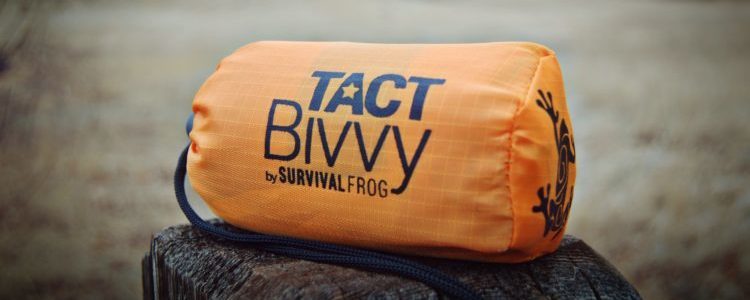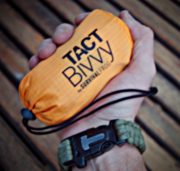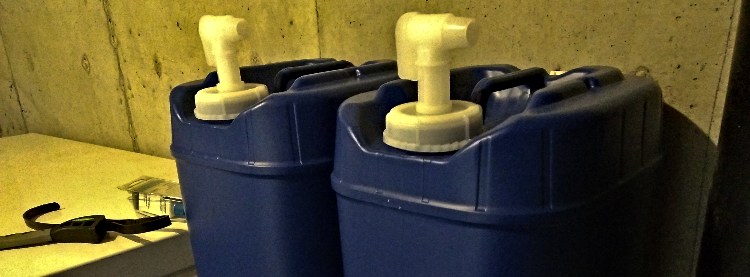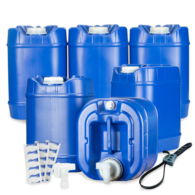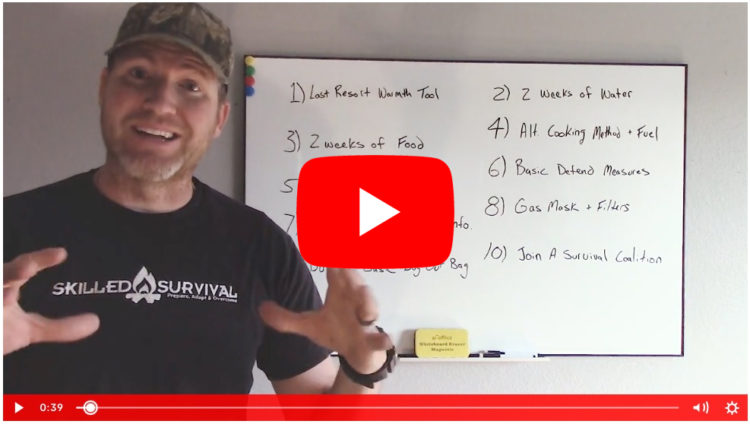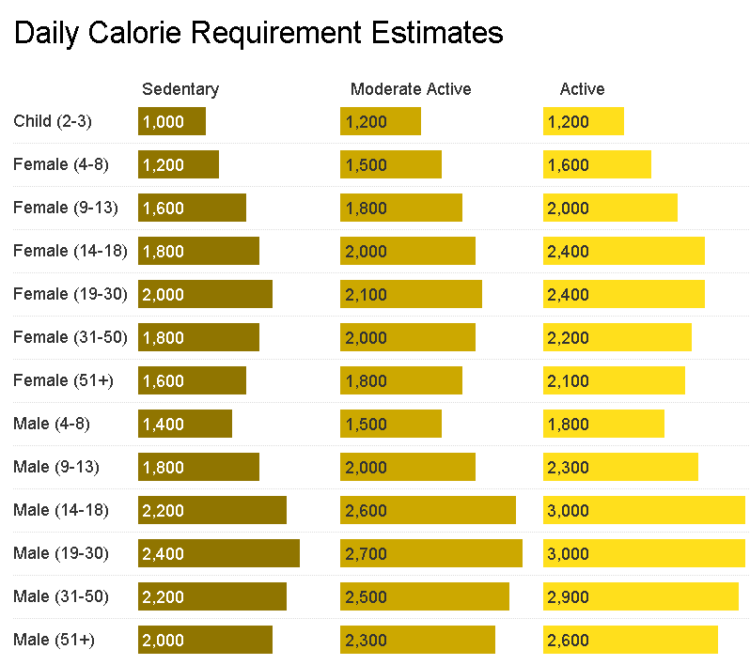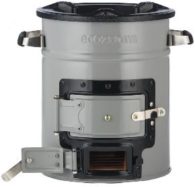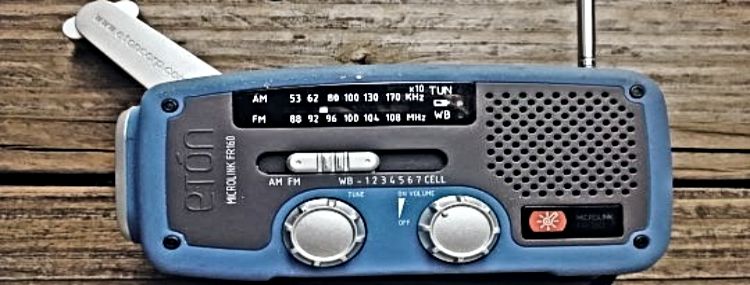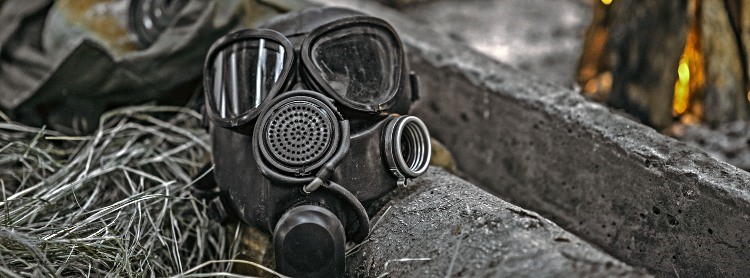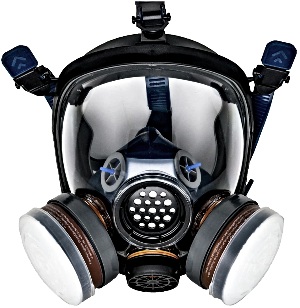
Because if you’re new to prepping, you’re likely feeling quite anxious! It’s natural to feel this way. Why? Because it’s terrifying to look in the mirror and realize how unprepared you are…
And if you’re not careful, this anxiety can grow.
It can develop into stress, sleepless nights, and a sense you’re running out of time. But if you harness these feelings correctly, they can be good! Why? Because they’re motivating!
Those gut-wrenching feelings are preparing you to take action. But once you decide “it’s time to prepare,” – you hit a roadblock.
Which actions should you take first?
And the amount of survival and preparedness information available today is STAGGERING…
There are hundreds of millions of blog posts, thousands of courses and books, etc.
- Where should you begin?
- What should you do first?
- Which courses should you buy?
- Which communities should you join?
- Who should you follow?
- Whose advice is trustworthy?
- Should you store water or food first?
- What about bugging out vs. hunkering down?
- How much will this cost?
- Are there any cheaper alternatives?
These are excellent questions. BUT NO ONE seems to have any clear answers. Just tons and tons of “random (sometimes contradictory) advice.”
UNTIL NOW…
I HEAR YOU, and I want to help YOU!
My name is Jack, and I’m a co-founder of SkilledSurvival.com & TheResilientLife.com.
I’ve been living and breathing prepping my entire life. And I’ve been sharing my thoughts and advice online since 2013.
Since that time, I’ve helped thousands of people along the way. And I get the same questions from those new to prepping:
“How do I start prepping? What should I do first, second, third, etc.”?
So I created a FREE Basic Prepping 101 Guide to help you make wise decisions from day one.
By following the 10 STEPS below, you’ll quickly stop being one of the “fragile masses.” (i.e., those who are 100% unprepared and utterly dependent on others when disaster strikes).
Instead, EACH step moves you in the right direction – towards a more resilient lifestyle.
Once you’ve completed all 10 steps, you’ll have an excellent base of supplies, tools, and the confidence to survive most future disasters.
1. Invest In A “Last Resort” Warmth Tool
Note: feel free to skip if you live in a temperate climate year-round
Right out of the gate, this first step is a bit controversial in survival.
Some survivalists suggest stockpiling clean drinking water is your #1 priority. And for most disasters, that is 100% correct. Why? Because you can only survive about three days without water.
However, you won’t survive long in below-freezing temps without a way to stay warm. And this is possible in places like Michigan in mid-February if the power goes out.
That’s why I recommend you invest in one TACT Bivvy for every household member.
You can skip this one if you have a wood stove or fireplace and a nice wood pile. But if not, then get some TACT Bivvys.
They work by trapping your body heat (such as when you’re shivering uncontrollably).
And it’s made of Mylar (which doesn’t allow air particles (or heat) to pass through it).
Hopefully, you’ll never need a TACT Bivvy, but it could save your life if you do.
2. Stockpile 2 Weeks Of Water
Why two weeks? Why not more? Because if you’re starting, this amount of water is attainable within a short time frame.
Or, as I like to say, “It’s doable and affordable.”
Plus, it establishes the safety net for most future disaster scenarios.
Sure, it’s not enough for the long-term “doomsday” scenario. However, with two weeks’ worth, you’re covered for the most likely disasters.
Many people ask me, “Why 1 gallon per person per day? That seems more than necessary…”
It might be, but here’s why I say 1 gallon per person per day:
1. I’d rather have slightly more water than not enough for two weeks.
It’s hard to say how hot it might be (especially without an AC unit running).
When it’s hot out, your body needs more water to replace the water loss due to sweating.
2. You’ll also need water for Cooking and Sanitation – so you’ll only consume about half the water you’re storing.
You’ll use the other half for cooking meals and hygiene.
Now you could buy bottled water from the grocery store IF that’s the best you can do short term. But, if you have the means, I recommend getting quality water storage containers.
I selected Legacy Storage’s water containers, and if you’re interested in seeing what I did, feel free to read my step-by-step article here.
I’ve also written a blog post called 9 Best Water Storage Solutions and Mistakes To Avoid.
Once your two weeks’ water is secured, it’s time to shift your focus to the next step…calories.
Click here to get the free 10 Baby Steps To Preparedness video training and downloadable PDF
3. Stockpile 2 Weeks Of Non-Perishable Calories
Why two weeks? Why not more? Because (like water), if you’re starting out prepping, it’s an amount of food attainable within a relatively short time frame.
Again, it’s not nearly enough for a long-term “doomsday” scenario. But with two weeks of calories per family member, you’ll survive most short-term disasters.
How do you decide how many calories equate to two weeks’ worth of emergency food?
I made this easy-to-use calorie chart to help:
For each family member – use the gender/age (across the side) and activity level (across the top) to get their approximate calorie per day number.
Then multiply that number by 14 (i.e., two weeks).
Finally, add up each family member’s two-week calorie needs.
You now have your entire family’s two-week calorie requirement!
Now you can either go one of two directions to stockpile calories:
- DIY (do it yourself)
- DFY (done for you)
Do It Yourself
If you go the DIY route, you’ll buy bulk sacks of rice and beans and acquire lots of spices to make bland food palatable.
Plus, you’ll want to stock up on large jars of peanut butter – which are always a wise addition.
You could also make your own hardtack (a long shelf-life cracker).
For meat, you could make your own pemmican.
So as you can see, the DIY route is not quick OR easy. Because when you do it right, it takes a lot of time and energy.
If this sounds daunting, I suggest you take a shortcut and go with the Done For You (DFY) route.
Done For You
I recommend you check out Valley Food Storage OR Legacy Food Storage.
Both companies have first-rate freeze-dried meals that are well packaged and can last 25+ years if stored in a cool, dry, vermin-free location.
You should also add some 25+ year canned meats to your survival pantry.
The bottom line is:
You MUST put some time, energy, and funds into getting a two-week supply of non-perishable foods into your pantry ASAP.
The sooner, the better!
Sure, more food and water stockpiles will be a BIG focus once you finish all 10 steps. But it’s time to move on to the next step – how to cook this food without relying on your power company.
4. Alternative Cooking Method
You can have all the rice, beans, or freeze-dried foods you want – but it’s NOT very useful if you CAN’T cook it.
You need a way to boil water as your most basic food prep.
Now, there are all sorts of advanced solutions to this, including:
- Wood cookstoves
- Solar ovens
- Backpacking stoves
- Etc.
And in a pinch, a backyard fire pit can also work – but it’s not very efficient.
You’ll go through a wood stockpile way too FAST that way.
So instead, I recommend investing in a rocket stove (one of the best ones for simple water boiling is the Eco-Zoom Versa).
So you can buy a rocket stove or DIY and build your own.
But the bottom line is: A rocket stove is the most efficient way to boil water using wood. Heck, you can use small twigs and sticks to boil water.
The key is getting the most heat from the least amount of fuel, which is exactly what rocket stoves do.
Now you should also invest in fuel for your rocket stove.
Don’t assume you can find enough firewood after a disaster occurs.
So, stock enough firewood to cook two weeks’ worth of food you’ve stockpiled.
This amount will depend on how large your family is.
BONUS:
In a winter power outage, you can heat a small outdoor hut or shed with your rocket stove.
Just be very careful of burning wood inside a home or contained space.
Not only is there the risk of starting a fire, but the fumes can accumulate and become toxic to breathe. But a rocket stove could save your fingers and toes from frostbite in a pinch.
Note: Here’s an article about rocket stoves (including some of the best ones on the market today, plus some DIY ideas).
Click here to get the free 10 Baby Steps To Preparedness video training and downloadable PDF
5. Invest In A Hand Crank Radio
This one is simple – invest in a quality hand-crank radio.
In any widespread disaster, where chaos dominates the day, you CAN’T rely on electrical power. Because if the power goes out, how will you find out what the HELL is going on?
- Is it safe to go outside?
- Are more attacks happening? Where?
- Is the water supply compromised? Are roadblocks in place?
- Is the storm passed?
- Where is flooding the worst? Etc.
Most electronic devices (TVs, Computers, phones) won’t work when the power is out.
That’s why you need to get a hand-crank radio.
It’s exactly what it sounds like – an AM/FM/Weather radio that includes a hand crank generator.
I like the Scorpion II Multi-Powered Weather Radio & Flashlight by Eton.
The hand crank allows you to generate your own power to charge the radio’s battery.
Plus, with some advanced models, you can use the hand crank to charge a phone.
A hand-crank radio is one of the BEST and first pieces of prepping gear you should buy.
Ensure you buy a quality one since it may become your main lifeline for information in a crisis.
NOTE: Here’s an article that reviews many of the best hand-crank radios on the market today.
6. Basic Defense Measures (Home & Personal)
This one is tricky because each person’s current situation is different.
So I will focus on the “bare minimum” for home and self-defense.
Of course, the more defense measures, the better. But these are Basic Steps, so get these in place first if you’re 100% fragile in these important defense categories.
Personal Defense
Ideally, for personal defense, you’re trained to use firearms and have plenty of ammo to go with your sidearm of choice. And preferably, you also have some martial arts training as well. But I consider both of those more advanced personal defense measures.
I recommend investing in a high-quality pepper spray if you’re truly starting from scratch in the personal defense department.
Pepper Spray
Pepper spray has proven to be a powerful deterrent to attackers.
They are also non-lethal and straightforward to use (point and spray).
Plus, you can easily carry a small canister just about anywhere.

Plus, the Police use it around the country, and it’s the right size to neutralize several attackers if necessary.
Home Fortification
Home fortification can be a tricky topic to discuss.
Everyone’s situation is so unique. For example, renters have fewer options than homeowners. But I believe there are bare minimum strategies you must put in place from a home defense – which include:
Install Deadbolts and Basic Alarms
Deadbolts have proven to slow down forced entries significantly.
Deadbolts prevent single kick break-ins, and when paired with a door reinforcement kit, they can withstand a battering ram (see video here).
So with a deadbolt, a forced entry situation will take longer and create more of a ruckus.
Both time and noise are significant deterrents for thieves or bandits.
If you rent and don’t have deadbolts, I recommend you make a formal request to the landlord.
I think it’s inexcusable for a landlord to be so cheap to refuse to install deadbolts.
NOTE: Most landlords will want to avoid the potential liability and install deadbolts if your formal written request includes the following:
“I am concerned about my safety.”
Now, if you rent, whether you have deadbolts or not, you should invest in a door stop alarm OR door jammer bar for each entry point.
You can put these tools in place nightly or keep them for a future disaster.
They’re an added layer of security when you’re frightened and want something extra to prevent a hostile break-in.
Plus, many of the doorstop or jammer bars include alarm triggers built-in.
So not only are you securing your doors, they will alert you and your neighbors should someone try to break in.
Now for homeowners, ideally, you have deadbolts. And if you have the means, a basic alarm system.
You don’t need an expensive hard-wired system.
I’ve installed a self-monitoring alarm system by Abode (here’s their starter kit) – it works great for my needs.
I have heard good things about the Ring Security System, which also pairs nicely with the Ring Video Doorbell.
Also, I recommend installing motion-sensing lighting near ALL entryways – especially doors in a backyard or ones with concealment nearby (fence, bushes, shed, etc.).
The bottom line is:
You must make it more of a challenge for someone to break into your home than your surrounding neighbors.
That way, an intruder will likely move on to easier targets.
That’s the goal with this step – target hardening!
Do as much as possible; ideally, you secure your doors, add an alarm, and motion-detecting lights (if possible).
NOTE: Here’s an article I wrote about how to reinforce doors (which includes information about door stop alarms and door jammer bars – plus so much more).
P.S. If you install motion-sensing lighting, ensure any potential intruder can’t just walk up to the bulb and twist it off.
That’s why I like these with integrated LEDs.
Many modern light covers have open bottoms to allow downcast lighting, but you’ll want to modify the light cover to prevent this vulnerability.
OR install a security floodlight high enough to prevent quick access.
Click here to get the free 10 Baby Steps To Preparedness video training and downloadable PDF
7. Basic Medical (Emergency Supplies & Know-How)
It’s essential to keep a basic first aid kit in your home. And you must be able to use the supplies in that medical emergency kit.
You can’t rely on your family doctor, urgent care, or the ER during a widespread disaster.
Why? Because first off, the emergency rooms may be full. Especially when you layer on a global pandemic like we are experiencing in 2020, causing ICUs to already be at full capacity.
OR, worst yet, it may be too dangerous to attempt a journey to get to them. And if things are bad enough, doctors and first responders may choose to stay at home.
They will prioritize their family’s safety instead of heading into the hospital. Either way, just like power, you’re utterly fragile if you don’t have any medical supplies in your home.
That’s why you must learn basic first aid AND have the supplies you need to perform that first aid in a pinch.
I highly recommend you invest in a MyMedic First Aid Kit and The Survival Doctor Handbook.
I’ve reviewed both of these products and vouch for their quality.
Here are a few of the MyMedic kits you can choose from:
And here’s my review of The Home Doctor:
↓ Home Doctor Book Review: Is It Worth Buying? ↓
With these two resources in place, you’ll be ready to provide some basic medical care in a pinch. That’s a much more resilient way to live.
NOTE: Here’s an article about building your own medical survival kit (if you choose to go the DIY route instead).
8. Invest In A Quality Gas Mask (& Filters)
Now you may be thinking, “A Gas Mask?
That sounds like an ADVANCED prepping tool,” – but you’re wrong. Why? Because if the air you breathe ever becomes toxic, without one, you’re screwed.
If it’s a nasty chemical attack, you could die within a few hours.
If it’s nuclear fallout, you’ll die in a few months…
Here’s a list of just a few of the disasters a gas mask is necessary to support your survival:
- Nuclear Attacks (fallout)
- Chemical Attacks (lots of air-based toxins)
- Out of Control Riots (tear gas – or worse)
- Super Volcanic Explosion (ash fallout)
- Deadly Pandemics (viruses)
- Wildfires (smoke/ash)
So every household should own at least one gas mask (plus a few filters).
Ideally, you’d get a gas mask for each family member – but the costs can increase quickly.
If you own at least one, the rest of the family can remain hunkered down.
Usually, you only need one person to leave home for supplies runs, etc.
It’s not ideal, but having at least one gas mask gives you a chance and MORE options in a worst-case scenario.
Now, I’ve spent hours and hours researching different gas masks and manufacturers. And I’ve settled on two leading suppliers:
Both of these masks are high quality AND worth every penny.
You’ll need to buy at least one gas mask per family (feel free to buy one per person if you have the means to do so).
You’ll also want to buy AT LEAST two gas mask filters per mask.
That way you’ll have be able to safely leave your home or bunker for short periods of time.
NOTE: I wrote an extensive gas mask article if you have any questions or want to do more research.
Click here to get the free 10 Baby Steps To Preparedness video training and downloadable PDF
9. Build A Bug Out Bag
If you’re new to prepping, you’ll want to hunker down for most emergencies.
Why? Because leaving the safety of your home and supplies could end in disaster.
Most disasters will have an apex. There will be a ramp-up of chaos, but things will settle a bit at some point, and a cleanup period will begin.
It’s safer to hunker down and wait things out for these disasters.
However, with that said, there are disasters when hunkering down is NOT possible. Take a flood or fire, for example.
If your neighborhood is flooding or burning, staying would be STUPID.
Everyone must assemble a small go-bag or bug-out bag filled with necessary supplies to grab immediately.
↓ 7 Reasons Why EVERYONE Needs A Bug Out Bag ↓
You’ll want to be able to grab your loved ones and your bug-out bags and be out the door in under 1 minute.
Don’t worry about having a bug-out location right now – that’s for advanced survivalists…
Again, you will stay home unless the disaster forces you out. And if you’re forced out, get away from the path of danger and find some open land or campsite to wait things out.
Also, don’t assume your vehicle will be available.
Sure, it probably will be for most disasters, but you must plan for the worst, which means walking.
So think about the safest travel paths to exit your neighborhood.
NOTE: Today should also be the day you look at the ½ full mark on your gas tank as your new EMPTY. Why? Because gas will be hard to come by in an emergency.
Having at least half a gas tank in your vehicle is wise.
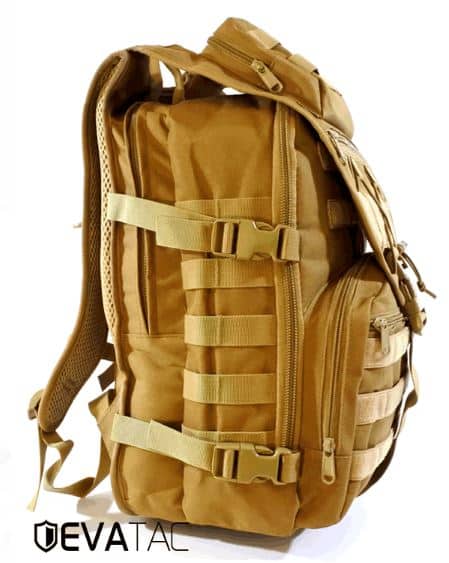
It’s got quality buckles, lots of compartments, and a MOLLE strap system, and it’s about the right size (not too big or small).
It’s the bag I use for my bug-out gear and supplies.
NOTE: Here’s my 104-Item Bug Out Bag Checklist article – this will help give you some ideas on what to put into your Bug Out Bag.
Remember, this is an idea list – I DO NOT recommend you put EVERYTHING on the list in your bug-out bag because it would quickly become TOO HEAVY.
↓ 10 Tips To Reduce Your Bug Out Bag Weight ↓
10. Join A Survival Coalition
Once you’ve completed Basic Prepping 101 Steps 1-9, you have a simple survival plan for all major categories.
- WARMTH
- WATER
- FOOD
- COOKING
- COMMUNICATIONS
- DEFENSE
- MEDICAL
- AIR
- BUG OUT
So I want to say, “CONGRATULATIONS – your prepping basics are taken care of for MOST future disasters that may last multiple weeks!
Take a deep breath and celebrate; this journey was likely a massive achievement for YOU!!
Yet, with that said, it’s NOT ENOUGH if you want to live a resilient life.
Sure, what you now have in place is better than nothing. But you’re still fragile to any epic disasters or ones that last more than just a few weeks. But the good news is, NOW you’re ready to move into advanced levels of prepping.
You’re ready to begin your journey of creating a resilient life.
I’m talking about a life where most decisions and choices focus on reducing your fragility to life’s uncertainties.
For example:
- Having less debt and more cash makes you less fragile to financial crises (both personal and global).
- Creating a rainwater collection system to capture rain off your roof – gives you a “FREE” fresh supply of water should the taps ever run dry. This system makes you much less fragile than a shared municipal water delivery system.
- Build a side business to create resiliency in your career and cash flows.
- Growing a backyard garden adds resiliency to your life by providing food to your table that’s not JUST from a grocery store.
- Mastering bushcraft and survival skills help you survive accidents in the great outdoors.
These are just a few actions to help reduce your fragility and increase your resiliency. And as you become more resilient, you’ll likely feel less stressed, calmer, happier, and more fulfilled.
You’ll be proud of what you’ve accomplished, and you’ll be able to relax and enjoy life much more.
Living a resilient life STARTs by reducing anxiety and stress. But once you get past the basics and join the resilient few – you’ll begin enjoying your life MORE.
I genuinely believe our modern culture of extreme luxury and comfort is fragile. And it’s NOT fulfilling or creating truly long-lasting satisfaction and happiness.
My answer is The Resilient Life—a system I built to help you become the BEST, MOST confident, and PREPARED version of yourself.
A member of the “resilient few” who’s ready for WHATEVER storms of life come your way.

Prepare, Adapt & Overcome,
P.s. - I just found out 2 out of 3 Americans don’t feel prepared for a 3 day disaster!!!
I guess this goes to show how modern society continues to embrace ‘living a fragile life.’ What’s crazy is… it’s so easy to fix.
To make sure YOU have the basics, watch our FREE training on “10 Simple Steps To Basic Preparedness” that shows you HOW.
Nothing crazy here… this isn’t doomsday prepping... just the basics every responsible adult should have before a disaster strikes.Why You Can Trust Skilled Survival...
Go here now to review a full breakdown of:
- Who We Are
- Our Credentials
- Our Mission
- & Product Recommendations...
Here are a few highlights of our teams credentials & certifications:
- Certified Member of a Mountain Search & Rescue Organization
- Plant Emergency & Safety Leader for a Major Food Manufacturer
- Member of the 10TH Mountain Division Hut Association
- Certifications: Avalanche 1, WFR, CPR
- Official Gear Tester for Numerous Outdoor Gear Companies
- Countless Multiday Backpacking trips into Remote Wilderness
- Bachelor's Degree In Mechanical Engineering
- Bachelor's Degree In Civil Engineering
- Bachelor's Degree In Biomedical Engineering
"It takes 20 years to build a reputation and five minutes to ruin it." - Warren Buffett
We're fully aware that trust is NOT something you GET but is EARNED.
And we'll continue to earn YOUR trust through our forthright and honest approach with each new Blog Post, Guide & Product we create...
P.s - I just took this FREE 60-second 'Readiness Score Quiz'👇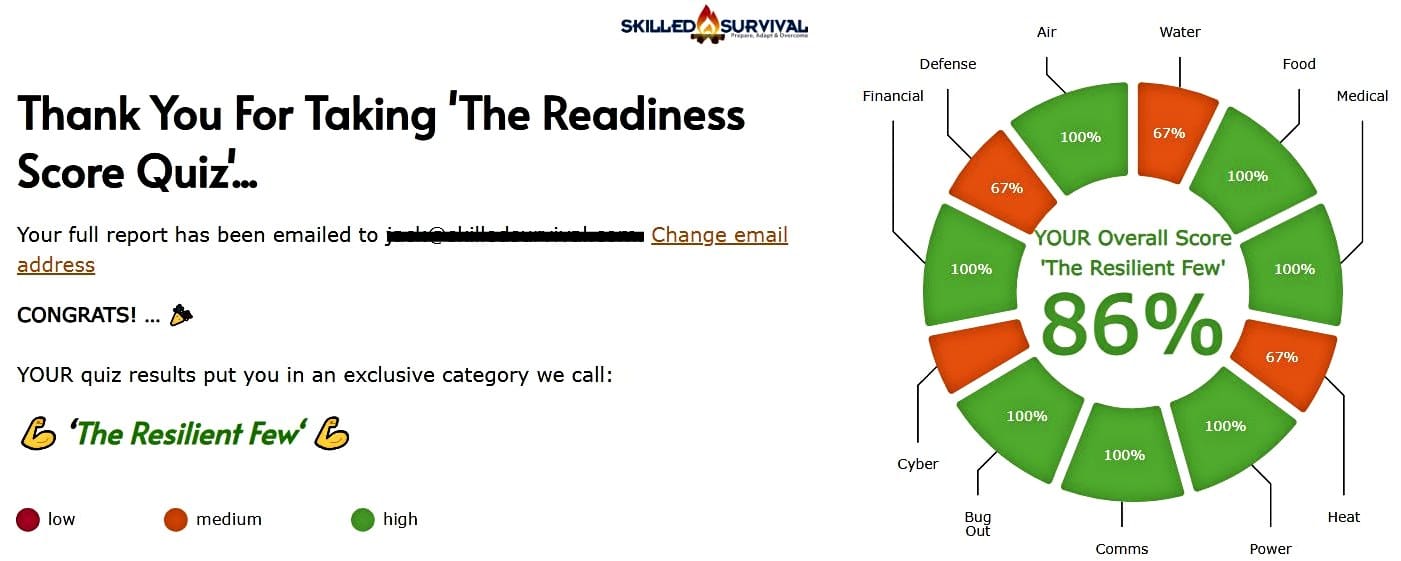
AND... I've still got a few gaps in my preps...🤔 But at least, I'm not part of 'The Fragile Masses'. 👍 Find out where YOU stand by answering a few questions...
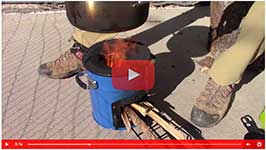
Recommended Reading
Valley Food Storage Review: An Expert Puts It To The Test
Unbiased and thorough Valley Food Storage review covering food supplies, packaging, taste, and shelf life. Don't buy without reading this...
Gas Mask: The Best One Chosen By A Preparedness Expert
Our testing and research found the MIRA CM-7M gas mask is the best when looking at value, effectiveness, durability, comfort, and protection.
Bug Out Bag Checklist: The 104 Must-Pack Items & WHY
Use my battle tested 104 item bug out bag checklist to ensure you don't forget anything critical before heading out the door.
Water Storage: Best Solutions & Biggest Mistakes To Avoid)…
The DOs and DON'Ts of long term water storage. We cover the best water storage containers to keep you safe for the long-haul.
How To Make Pemmican: A Super Long Shelf Life Protein
Learn how to make pemmican with this step-by-step guide. Plus, find out how long our pemmican recipe lasts and how it tastes.
Prepper Checklist: 78 Items You Should Stock & WHY
This prepper checklist covers (in detail) EVERY item you must stockpile today to prepare fast and avoid overlooking anything critical.

